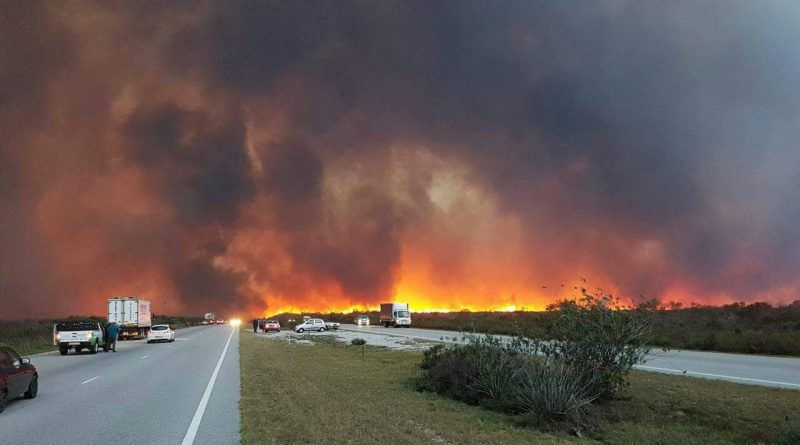Preventative measures can reduce the spreading of veld fires and damage to property
Runaway fires can be devastating as lives and property can be lost. Nothing can ever prepare one for the consequences of an unplanned, sporadic and ravaging wildfire. In the last few years, South Africa has witnessed several devastating veldfires that have cost the non-life insurance industry billions of Rands. In 2017, a devastating firestorm in the southern Cape engulfed large parts of Knysna, Brenton-on-Sea and parts of Plettenberg Bay, destroying over 1 000 properties in its wake and leaving behind almost 10 000 people evacuated and seven deaths.
Something as simple as a small flare can have devastating consequences if not managed correctly. It can destroy livelihoods, agricultural land and destabilise animal life and whole ecosystems. Runaway fires or veldfires are started by a small spark, but their rate of spread, intensity and levels of heat can be devastating.
“Uncontrolled veldfires pose a serious risk to the general environment, human life and property, as well as livestock in farm settings. Educating vulnerable communities and giving them the know-how of what can accelerate and increase the intensity of veldfires can assist in reducing their impact,” says Nico Esterhuizen, General Manager Insurance Risks at the South African Insurance Association (SAIA).
Ignitions sources of veldfires
There are several types of ignitions that cause veldfires, but most are started by humans for various reasons such as:
- Reckless disposal of lit cigarette stubs;
- Not properly extinguishing camping fire or braai stand after use;
- Smoking out of bees for honey harvesting;
- Lighting fires at road servitudes while waiting for early morning buses;
- Land clearing;
- Hunting
- Deliberate lighting of fires/arson
The importance of assessing the risk around our properties
Vegetation that is adjacent to our properties can be a source of fuel and can increase the impact of fires. Vegetation found around our property like shrubs, grasses, bark, (especially if it is loose), dead leaves and twigs can add fuel to the fire. Without additional fuels, fire dies, however when such vegetation is left around our properties, the fire will grow in its intensity and spread quickly.
To minimise the risk, we need to cut dry grass, regularly clean roof gutters as leaves tend to pile up and clog the pipes, trim trees and place loose wood 10 meters or more, away from our property.
Topographical features that negatively affect veldfires
Slopes affect the behaviour of fires. The fire runs faster uphill than downhill because the flame length is closer to other fuelling objects. North facing slopes are warmer and are more prone to fires because they are exposed to the sun. North facing slopes temperatures are high and the fuels like wood etc. are dry, thus can easily ignite and burn.
Fire assembly points
As a community, you can agree on a fire assembly point. This is a safe area beyond your community boundaries or area affected by the veldfire. When there is fire, people can evacuate their properties and congregate at an agreed assembly point. The importance of an assembly point is for the community to identify if there are missing people to notify the emergency personnel to search for them.
What can we use to put out fires?
Sand: By throwing sand on the fire, you are cutting off the oxygen and the fire will be put-out. Keeping a bucket of sand in your yard can help in an emergency.
Fire Blanket: A fire blanket is a sheet of a fire-retardant material which is placed over a fire in order to smother it. Always keep a fire blanket on your property.
Fire Extinguisher: These are common and are very important in fighting fires. Always ensure that your fire extinguisher is serviced regularly, and you know how to use it.
Fire Breaks: You can create fire breaks by digging shallow trenches around the perimeter of property. When digging fire breaks you remove other objects that may fuel the fire and it will not spread easily to other areas. In farm areas, larger firebreaks are required as the areas are open and prone to runaway fires.
Insurance products that we can take out to assist us in the event of veldfires
We can take out insurance products for our property and household to assist us in the event that a veldfire cannot be prevented and our belongings are destroyed. Appropriate / suitable / the right insurance product/s will ensure that we get back on our feet quicker by replacing the assets we may have lost in the fire.
It is imperative that policy and prospective policy holders are aware of what cover is provided for, and which items are covered by their policy. This information can be sourced from the insurance company itself or the broker.
The following are some of the insurance products that you can take out:
Homeowner/ Building Cover: This insurance covers the building and other things that are permanent and immovable within your property boundaries. Most homeowner / buildings policies include parameter walls, garage and gate and the motors that power them, outbuildings, swimming pool and/or borehole and associated pumps, and all the fixtures and fittings in the house or flat itself.
Household Contents Cover: Contents includes your furniture, clothes, crockery, linen and other items in the house. By taking out household-contents insurance cover, you know that when you are affected by veldfires, the insurance product will assist you by replacing, repairing or reinstating the damaged goods.
All Risk Cover: It covers your other items that you take with, like your cell phones, cameras etc. It will come in handy if any of these items are damaged by veldfires away from your home.
Public Liability Cover: This insurance product provides liability cover to the policyholder. As a homeowner you may make a mistake and leave burning fire outside at night. During the night the wind may blow, and the fire may spread to neighbouring’ properties. Should they be successful in proving that you were negligent and hold you liable for their losses, personal liability cover will then assist you against any law suits.
“It is important to have knowledge on how to recognise the weather conditions associated with high fire danger: temperature, wind speed/direction and humidity. Training staff in firefighting techniques and safety standards for burning rubbish and disposing of hot ash,” concludes Mr Esterhuizen.
Firebreaks and Safety from Fire in Rural and Farming Areas https://t.co/jYpCl96Gx5 #ArriveAlive #Firebreaks @wo_fire @vwsfires @BurnshieldZA pic.twitter.com/BLt7cFOJoG
— Arrive Alive (@_ArriveAlive) November 1, 2018




